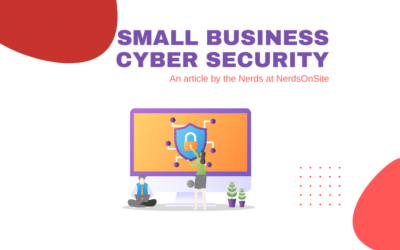The internet is full of bad actors—people with malicious intent out to steal your information and use it in potentially costly ways.
Article Contents
A new study by McAfee and the Center for Strategic and International Studies (CSIS) suggests the cost of global cyber-crime was $600 billion last year. That is a frightening increase from 2014 when the same analysis showed the cost was $445 billion.
Cyber-security is an increasing issue. With the ability to connect multiple devices to your personal network, there is an even greater need to protect yourself.
If you’re not worried about your cyber-security already, you should be.
Read on to learn about what malware is, the different types of malware, and how you identify when you’ve been infected.
What Is Malware?
“Malware”, or malicious software, are programs designed to infiltrate and damage computers or devices without the user’s consent. This term covers all different types of threats to your device security.
Malware is often installed on computers without the user’s knowledge. It can be disguised as a trusted application or download, infecting a device with a simple click on a link. This is normally accomplished through phishing, but with the advancement of technology, it can be done through smishing as well.
What Does Malware Do?
Malware inflicts damage ranging from relatively harmless to very serious. This damage can include unwanted ads, system crashes, loss of access to files, financial losses, and even identity theft depending on the type of malware.
What Are The Most Common Types Of Malware?
The five most common types of malware are:
- Cryptominers
- Banking Trojans
- Adware
- Spyware
- Ransomware
Each type of malware has a different goal and method of attack.
Cryptomining
Cryptomining malware allows a hacker to use a device’s processing power to pull illegal funds from cryptocurrency sites—without the device owner’s knowledge or consent. This malware ends up on a user’s device when they visit a safe-looking website or download an app.
What Can This Type Of Malware Do?
Cryptomining malware is the least worrisome of all the types of malware out there—this type of malware does not gather your personal information, but it does use a large amount of your device’s resources and energy. This can result in slowed performance or a system crash.
How Can You Tell If You’re Infected With Cryptomining Malware?
Cryptomining is difficult to detect. You may notice your device has slowed down. A high Computer Processing Unit (CPU) usage is one indicator of cryptomining malware on your device.
You can check if your CPU usage is high by using a resource monitor on your computer. On a Windows PC it will be under Task Manager, and on a Mac it will be under Activity Monitor. If you notice high CPU usage when everything is closed, or when on a website that should not require much CPU usage, you may have a cryptomining malware on your device.
Banker Trojans
Banker Trojans are types of malware programs that target online banking systems. The goal of the attack is to steal sensitive information, login credentials, and eventually the user’s funds.
This type of malware generally ends up on a user’s device by malicious email attachments or by links to compromised websites.
Once the malware is on the device, the attacker waits for the user to visit a banking system. The trojan can then use a few ways to access the data:
- Track keystrokes via a keylogger (to steal credentials)
- Show popup forms that look legitimate
- Redirect user’s to a website that looks like the real one
What Can This Type Of Malware Do?
Banker Trojans have the ability to:
- Download and send files
- Steal information stored in your device’s clipboard
- Track what you type into forms
- Be removed from the infected computer by the attacker
Once enough information is collected, the Banker Trojan can then access the user’s bank account and personal information.
How Can You Tell If You’re Infected With Banker Trojan Malware?
You may notice a few things happening that can indicate banker trojan malware:
- Your browser keeps getting redirected
- Popups keep appearing with scary warnings
- There are forms on your banking website that ask for more personal information than usual (such as your SIN)
Adware
Adware is a type of malware that relentlessly shows popups and ads to the user. It’s usually more annoying than anything. However, having adware on your device can lead to performance issues, slowing down your computer and interfering with system functions.
This type of malware can end up on your device by downloading an app or another type of software (such as freeware or shareware).
What Can This Type Of Malware Do?
Once adware is on your device, there are lots of things it can do:
- Record your browsing behaviour, and then display ads based on the types of websites your visit and your location
- Slow down your computer
- Interfere with basic device functions
- Use up your data and bandwidth
How Can You Tell If You’re Infected With Adware?
There are a number of ways to tell if adware is running on your device. A few indicators include:
- Ads show up where they shouldn’t
- Your homepage has changed without your permission
- Website links redirect to sites different from what you expected
- Your web browser slows or crashes
Adware is usually no more than an annoyance, but when coupled with Spyware, it becomes a serious threat.
Spyware
Spyware is a type of malware that gathers personal information. It generally ends up on your device undetected, making its way onto your computer without your knowledge or permission.
Spyware can infect your system in the same ways that any other malware does, such as:
- Clicking a link or opening an attachment in an email
- Installing “Useful Tools” such as an Internet accelerator, download manager, or hard disk drive cleaner.
- Hiding in software bundles
What Can This Type Of Malware Do?
Spyware has the ability to steal your internet history, contacts, passwords, and other sensitive information. In the case of mobile devices like smartphones and tablets, it can steal information including:
- Incoming/outgoing SMS messages
- Incoming/outgoing call logs
- Contact lists, emails
- Browser history
- Photos
Spyware also has the ability to log your keystrokes, record conversations from your microphone, take pictures, and track your location using GPS—all without your knowledge!
Not only is it an invasion of privacy, but it can cause several other problems as well such as significant reduction in processor or network connection speeds, increased data usage, and low battery life. Unfortunately, it can be difficult to detect.
How Can You Tell If You’re Infected With Spyware?
There are several ways to help determine if you have been infected by Spyware. The following are potential signs:
- Mysterious files start appearing on your device
- You find emails in your ‘sent’ email folder that you did not send
- You conduct a search and another browser window pops up with related searches
- Your device becomes slow and sluggish
Ransomware
Ransomware is a form of malware that encrypts or removes data on your device so it becomes inaccessible. It can’t be decrypted or returned without a key that is only known to the hacker.
Ransomware attackers put thought into who they go after—they look for opportunity. The attackers will look for organizations that seem more likely to pay a ransom (like government or medical institutions) or organizations with sensitive data that are willing to pay to protect the value of their reputation (such as law firms).
What Can This Type Of Malware Do?
The attacker only offers the files to be decrypted or returned if a ransom is paid. Users are then given instructions on how to pay the ransom (usually in the form of cryptocurrency). Unfortunately, paying the ransom does not guarantee the files will be accessible again.
Ransomware most often infects a device with phishing or smishing scams, or through security loopholes.
How Can You Tell If You’re Infected With Ransomware?
Of all the types of malware, ransomware is probably the easiest to detect. The following are indicators you have been infected:
- A screen appears when starting your device that prevents you from using it
- Files on your computer won’t open
- You have received instructions for paying a ransom
How Can You Protect Yourself from Malware?
There are a number of things you can do to keep you and your personal information as safe as possible:
- Avoid opening suspicious-looking emails and text messages
- Download apps from your device’s app store instead of through websites
- Any transactional-type internet usage (banking, online shopping, etc.) should be done on a network you can trust
- Back up your information regularly
- Be careful of what information you share online and through apps on your devices
- Use different passwords for your accounts and devices, if possible
- Ensure your family, friends, coworkers, and anyone else you may contact through your network are up to speed on how to protect themselves as well
Being aware of the threats is the first step in ensuring your information stays safe. As always, our Nerds are available if you need help!













